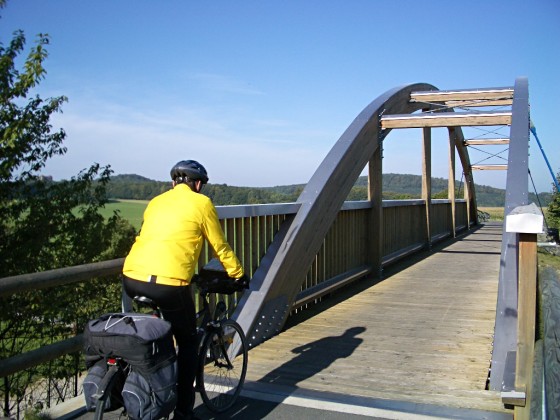Early in the morning we continue along the Ulster until just before Hilders a new bike path, the Milseburgradweg (Milseburg cycle path), begins. Again it is an abandoned railroad track with station houses and signals. It goes steadily but gently uphill. On boards the history of the railroad is presented and the route profile is shown. There I discover that the railroad leads at the apex of the mountain route through a tunnel and next to it is written: bypass route. I fear that the tunnel cannot be used and that I have to cross the mountain. Great is the joy when it turns out, the bike path leads through the tunnel. It goes downhill. It is a wonderful experience to whiz through the 1.2 km long tunnel. Subsequently, the ride is always slightly downhill until just before Fulda.
The Milseburgradweg always climbs gently uphill. In the picture the former train station Eckweisbach
To read the instructions for the use of the Milseburg tunnel click on the picture!
Entry into the Milseburg tunnel
In the tunnel: Come on, now we're going downhill!

Such beautiful bridges - here over a road - have been built for cyclists.
The original railroad track leads to Fulda station, but just before Fulda the glory is over and the bike path stops, or continues on normal roads on the sidewalk.
Through the Paulus gate we come to the Domplatz(cathedral square). In my documents we find a favorable inn on the other side of the small river Fulda. When we ask a cyclist for directions and he figures out that we rode from Leipzig to here, he leads us to the inn. Is it a coincidence? We are riding exactly on the Way of St. James! Without luggage we go by bike to the city sightseeing. We arrange to meet for a guided tour of the city at 15:00 at the tourist office. Now I look for the office of the Rhön Club. He is responsible for the marking of the Jakobsweg. There I have ordered via Internet hiking map and leaflet, but not yet paid. Unfortunately, the office is closed and I put the money in an envelope. Then I visit the Cathedral Museum and admire the silver reliquary of Bonifacius.

The Paulus Gate leads to the Cathedral Square
Fulda Cathedral, built from 1704 to 1712 according to plans by the cathedral architect Johannes Dientzenhofer. The towers of the Romanesque predecessor church were used in part.